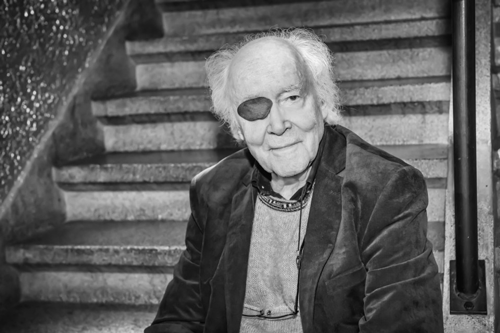Francis Dhomont

(c) Bea Borgers
Francis Dhomont studied under Ginette Waldmeier, Charles Koechlin and Nadia Boulanger. In the late 40’s, in Paris (France), he intuitively discovered with magnetic wire what Pierre Schaeffer would later call “musique concrète” and consequently conducted solitary experiments with the musical possibilities of sound recording. Later, leaving behind instrumental writing, he dedicated himself exclusively to electroacoustic composition.
An ardent proponent of acousmatics, his work (since 1963) is comprised exclusively of works for fixed media bearing witness to his continued interest in morphological interplay and ambiguities between sound and the images it may create.
The Conseil des arts et des lettres du Québec has awarded him a prestigious career grant. In 1999, he was awarded five first prizes for four of his recent works at international competition (Brazil, Spain, Italy, Hungary and Czech Republic). In 1997, as the winner of the Canada Council for the Arts’ Victor Martyn Lynch-Staunton Award, he was also supported by the DAAD for a residence in Berlin (Germany). Five-time winner at the Bourges International Electroacoustic Music Competition (France) — the Magisterium Prize in 1988 — and 2nd Prize at Prix Ars Electronica 1992 (Linz, Austria), he has received numerous other awards.
He is the editor of special issues published by Musiques & Recherches (Belgium) and of Électroacoustique Québec: l’essor (Québec Electroacoustics: The Expansion) — for Circuit (Montréal). Musical coeditor of the Dictionnaire des arts médiatiques (published by UQAM), he is also lecturer and has produced many radio programs for Radio-Canada and Radio-France.
In 1978-2005, he has divided his time between France and Québec, where he has taught at the Université de Montréal from 1980 to ’96. Since the fall of 2004 he lives in Avignon (France) and regularly presents his works in France and abroad. Great traveller, he participates in several juries.
He is an Associate Composer of the Canadian Music Centre (CMC, 1989) and a Founding Member (1986) and Honorary Member (1989) of the Canadian Electroacoustic Community (CEC). In October 2007, Université de Montréal awarded him a honoris causa doctorate. He is the president of the collective Les Acousmonautes (Marseille, France) — until its dissolution in 2016 — and “Ehrenpatron” (honour patron) of the organization Klang Projekte Weimar (Germany). He is awarded the Qwartz Pierre-Schaeffer 2012 (Paris, France), Baiocco d’oro 2012 (Perugia, Italia), and the Grand prize of the Giga-Hertz-Preis 2013 (Karlsruhe, Germany). In November 2014 he becomes an Honorary Member of the International Confederation of Electroacoustic Music (ICEM). In 2017 he becomes the Honorary President of the Festival Klang! (Montpellier, France).
He now focuses on composition and theory.
PHŒNIX XXI, 14’58 (2016)
To Inés Wickmann.
An archetypal symbol of rebirth and continuity, what is this musical Phoenix?
A trace / confirmation of the acousmatic vitality at the beginning of the XXI century, of course.
But, for me, it is also a new life given to ancient musical ashes, very old recordings and reanimated but transvestites extracts of instrumental works. A kind of eternal return, the present – so prominent today – being finally only the past of the future.
FD
Phoenix XXI was commissioned by the INA-GRM. The work comprises three movements in chains and was composed in the author’s personal studio in Avignon, France. World premiere on October 8th 2016 in Paris (MPAA Saint Germain), concert INA-GRM.
Selected by Futurs Composés, French Section of the International Society for Contemporary Music – ISCM, for the 2018 World Music Days in Beijing.
Honorary mention at the Musica Nova 2016 competition, Prague, Czech Republic.
©SACEM, Paris
Phonurgie, 12’30 (1998)
To Inés Wickmann and her found objects.
Phonurgie — “making, working, and creating sound” — presents, fifty years after the first gropings, and at the verge of the century under examination, one of the current states of this new art, which has become an independent art of sounds.
Unlike the other pieces in the Cycle, Phonurgie quotes no more than a passing subject of Schaefferian study, bringing the sound of this legacy to a close; on the other hand, the first part, Objets retrouvés, draws all of its material and its structure from it. Paraphrased elements from Novars can, of course, be found — elements that themselves paraphrase Étude aux objets, making them commentaries on commentaries — while the opening and conclusion make reference to AvatArsSon. Nevertheless, in this fourth homage, the allusions to the origins melt away before the original propositions; filiation is not renounced, but here the child, finally grown, reveals its identity.
While technology may have changed considerably and the “sound color” may no longer be the same, morphological thought and writing still remain, in all of their many forms, true to the ‘spirit’ of the first “concerts de bruit” (Noise concerts).
[English translation: Tom Carter]
Phonurgie — 4th of the 4 works in the Cycle du son — was realized in 1998 in the Syter studio of Ina-GRM (Paris, France) and at the composer’s studio, and it premiered on September 25, 1998 as part of the Inventionen ’98 festival (Berlin, Germany). The piece was commissioned by Deutscher Akademischer Austauschdienst (DAAD). Phonurgie won First Prize at CIMESP 1999 (São Paulo, Brazil) and First Prize at the 1st Concurso Internacional de Creación Electroacústica Ciber@RT (Valencia, Spain, 1999). In 1998 Phonurgie was included on the Inventionen ’98: 50 Jahre Musique Concrète disc (RZ 10009/10) and in 1999 on the Musica Maximalista 6: III CIMESP 1999 disc (CD 199008708).
Premiere:
September 25, 1998, Inventionen ’98: Concert concret, 1, Parochialkirche, Berlin (Germany)
Awards:
1st prize, Concurso Internacional de Creación Electroacústica Ciber@RT 1999, Valencia (Spain)
1st prize, International Electroacoustic Music Contest of São Paulo 1999, São Paulo (Brazil)
